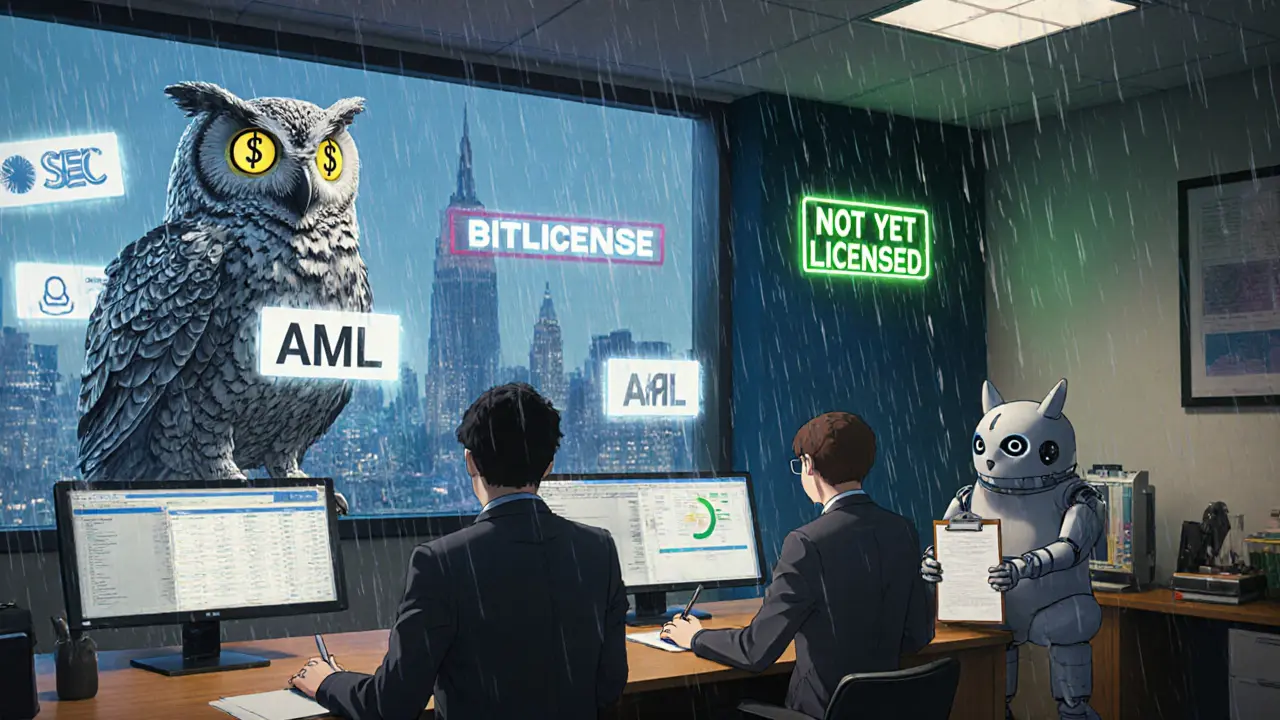U.S. Cryptocurrency Exchange Licensing Cost Calculator
License Requirements
Exchange Type
Additional Costs
Estimated Licensing Costs
Federal Requirements
State Requirements
Total Estimated Costs
Running a cryptocurrency exchange in the U.S. in 2025 isn’t just about building a good website or offering low fees. It’s about navigating one of the most complex legal mazes in the world of finance. If you think getting a business license is hard, try getting 47 different state licenses on top of federal registrations - all while keeping up with rules that change every few months.
Federal Licensing: The Three Pillars
Every cryptocurrency exchange that touches U.S. dollars must register with FinCEN as a Money Services Business (MSB). This isn’t optional. Around 92% of exchanges handling fiat currency are already registered, but many still get caught out by the details. The MSB requirement means you need a full Anti-Money Laundering (AML) and Counter-Terrorism Financing (CFT) program. That includes customer ID checks, real-time transaction monitoring that can handle 10,000 trades per second with 99.9% accuracy, and filing suspicious activity reports when something looks off. You also need to train your staff every year. Skip any of this, and you’re looking at fines, not just shutdowns.If you’re trading tokens that the SEC says are securities - like many tokens sold in initial offerings - you need to register with the SEC and FINRA. That means becoming a broker-dealer or an Alternative Trading System (ATS). Minimum net capital? $1 million. You can’t just wing it. The SEC has been aggressive in 2025, charging two major exchanges for listing unregistered security tokens. If your platform lets users trade tokens tied to company profits or revenue shares, you’re in securities territory. No gray area.
And if you offer derivatives - futures, options, leveraged trading - you must register with the CFTC as a Futures Commission Merchant (FCM) or Swap Dealer. That’s not cheap. You need at least $20 million in capital and membership in the National Futures Association. The CFTC also just issued new rules in September 2025: stablecoins must be 1:1 backed by cash or equivalents, and customer funds can’t be mixed with company money. No more using deposits to fund staking or lending without explicit consent.
State Licensing: The Real Nightmare
Here’s where most exchanges break. Forty-seven states require a Money Transmitter License (MTL) for any business moving crypto to or from fiat. That means you need a separate license for California, Texas, New York, Florida, and so on. Each one has different rules, fees, and capital requirements.New York’s BitLicense is the toughest. You need a minimum $500,000 surety bond or trust account. Your capital must match your business risk - for a high-volume exchange, that could mean $5 million or more. You also need DFS approval for every single coin you list. As of November 2025, only 47 cryptocurrencies made it onto the DFS Greenlist. If your token isn’t on it, you can’t trade it in New York - even if it’s listed on every other exchange in the world.
California’s rules are changing fast. The Digital Financial Assets Law (DFAL) kicks in July 1, 2026, but it’s already shaping how exchanges plan. You’ll need to meet capital and liquidity standards set by the Department of Financial Protection and Innovation (DFPI). Estimates range from $250,000 to $1 million depending on your volume. Kiosk operators have until July 2026 to comply - and they’re not exempt.
Texas requires $1 million in net worth. Illinois doesn’t require an MTL for crypto-to-crypto trades. Arizona has a simpler process. But if you want to serve customers nationwide, you need licenses in nearly every state. The average exchange applies for 45 to 50 state licenses. The process takes 12 to 18 months. Legal and compliance costs? Between $500,000 and $2 million.

The CLARITY Act: A Game Changer?
In mid-2025, the U.S. House passed the CLARITY Act - the biggest shift in crypto regulation since 2013. It creates a clear line between securities and commodities. Once a blockchain reaches “specified maturity” - meaning it’s decentralized, no single entity controls it, and it’s been live for years - its native tokens can be treated as commodities, not securities.This means exchanges trading Bitcoin or Ethereum won’t need SEC registration anymore. They’ll fall under the CFTC’s supervision as Digital Commodity Exchanges. The Act also creates a fast-track registration process for these exchanges and defines “qualified custodians” who can safely hold digital assets. Most importantly, it bans undisclosed use of customer funds. If you want to stake your users’ ETH or lend out their BTC, you need their written permission - and it has to be clear what the risks are.
But here’s the catch: the CLARITY Act doesn’t kill state licenses. New York still requires its BitLicense. California still enforces DFAL. The Act reduces federal overlap, but not state chaos. Experts say it’s a step forward - but it’s not a finish line.
Costs, Time, and Failure Rates
Getting licensed isn’t just expensive - it’s time-consuming and risky. The average application takes 150 to 200 hours of executive time just to prepare. You need business plans, org charts, cybersecurity protocols, capital proof, and detailed AML system descriptions. Then you wait. And wait.And 65% of applications get rejected or sent back for revisions. Why? Three main reasons:
- Insufficient capital (28% of rejections)
- Weak AML program design (35% of rejections)
- Unclear organizational structure or leadership (22% of rejections)
Compliance costs keep rising. Basic AML software runs $100,000 to $500,000 a year. Enterprise systems? Over $1 million. You’ll need at least three to five full-time compliance staff just to keep up. For a mid-sized exchange, compliance eats up 15% to 25% of total revenue.
That’s why the number of licensed U.S. exchanges dropped from 217 in 2022 to 142 in 2025. Smaller players can’t afford the cost. Big players are consolidating. If you’re a startup trying to launch a crypto exchange today, you’re not just competing with other platforms - you’re fighting against a regulatory wall built over a decade.

How This Compares to the Rest of the World
If you think this is bad, look at Europe. Under MiCA (Markets in Crypto-Assets), a single license from one EU country lets you operate across all 27 member states. Singapore has a streamlined process with clear categories: exchange, custodian, dealer. The U.S. forces you to apply for 47 licenses just to cover the states - and that’s before federal rules.Why does this matter? Because U.S. exchanges are missing out on global growth. While European platforms expand across borders with one application, U.S.-based exchanges are stuck playing state-by-state whack-a-mole. Meanwhile, 112 million U.S. adults own cryptocurrency - the largest market in the world. But most exchanges can’t legally serve all of them.
What’s Next?
The CFTC and SEC are still working on joint rules for mixed transactions - like when a token starts as a security and later becomes a commodity. That’s going to be messy. Some exchanges are already preparing for a three-tier system: SEC for new tokens, CFTC for mature ones, and state regulators handling consumer protection and money transmission.For operators, the path forward is clear: don’t try to do everything at once. Start with one state - maybe Wyoming or Texas, where rules are clearer. Build your compliance infrastructure before you scale. And if you’re planning to list tokens, make sure you know whether they’re securities or commodities - because the regulators will.
The U.S. crypto market is huge. But the cost of playing in it has never been higher. The licenses aren’t just paperwork. They’re the price of entry.
Do I need a license to run a crypto-to-crypto exchange in the U.S.?
Yes - but it depends. If you only trade crypto for crypto and never touch U.S. dollars, you might not need a Money Transmitter License in some states like Illinois. But you still need to register with FinCEN as an MSB if you’re transmitting value between users. If your platform supports any fiat on-ramps or off-ramps, you need an MSB registration and likely a state MTL. Always assume you need federal registration unless you’re 100% certain you never handle fiat.
How long does it take to get a cryptocurrency exchange license?
The federal MSB registration takes 4 to 8 months. State licenses vary: New York’s BitLicense can take 12 to 18 months. California’s DFAL process is expected to take 6 to 12 months once applications open in 2026. Applying for 45+ state licenses could take 2 to 3 years total. Most exchanges don’t apply for all at once - they start with key markets and expand over time.
Can I operate a crypto exchange without a license?
Technically, yes - but you’re breaking the law. The SEC and FinCEN actively monitor transactions and have shut down unlicensed exchanges since 2019. Penalties include fines up to $1 million per violation, criminal charges, and permanent bans. In 2025, two major exchanges were charged for operating without proper registration. The risk isn’t worth it - especially when the market is already crowded and regulated.
What’s the difference between a BitLicense and a regular money transmitter license?
The BitLicense is New York’s version of a money transmitter license, but it’s much stricter. It requires DFS approval for every cryptocurrency you list, higher capital requirements ($500,000 minimum bond), and ongoing reporting on cybersecurity, governance, and customer complaints. A regular MTL in other states doesn’t control which coins you can trade. BitLicense gives New York direct oversight over the assets themselves - not just the money flow.
Is the CLARITY Act going to make licensing easier?
It will help - but not eliminate the complexity. The CLARITY Act reduces federal overlap by letting mature cryptocurrencies trade as commodities under the CFTC, not as securities under the SEC. That means fewer federal registrations for Bitcoin and Ethereum exchanges. But state licenses like BitLicense and DFAL still apply. You’ll still need multiple state licenses, and compliance costs won’t drop overnight. It’s a step toward clarity, not a shortcut.
How much capital do I need to start a crypto exchange in the U.S.?
Minimums vary. Federal MSB registration doesn’t have a capital requirement, but state rules do. New York: $500,000+ in capital or trust. Texas: $1 million net worth. California (starting 2026): $250,000 to $1 million based on volume. Plus, you need $1 million for SEC registration if trading securities, or $20 million for CFTC registration if offering derivatives. Total startup costs for a fully compliant national exchange? $2 million to $5 million minimum - not including tech, staff, or AML systems.
What happens if I get rejected for a license?
You can reapply, but you’ll need to fix the reason for rejection. Common fixes: increase capital reserves, rewrite your AML program to meet specific regulatory standards, hire a compliance officer with crypto experience, or restructure your corporate ownership. Rejection doesn’t mean you’re banned - but multiple rejections hurt your credibility. Regulators track applications. If you’re turned down twice in New York, your third application will be scrutinized even more closely.
Can I outsource compliance for my exchange?
You can outsource some tasks - like AML software, transaction monitoring, or background checks - but you can’t outsource responsibility. The exchange’s leadership is legally accountable for compliance. Regulators will hold the CEO and compliance officer responsible, even if a third party made a mistake. Use vendors to help, but keep internal oversight. At least one full-time compliance professional should be on your team.







Write a comment
Your email address will be restricted to us